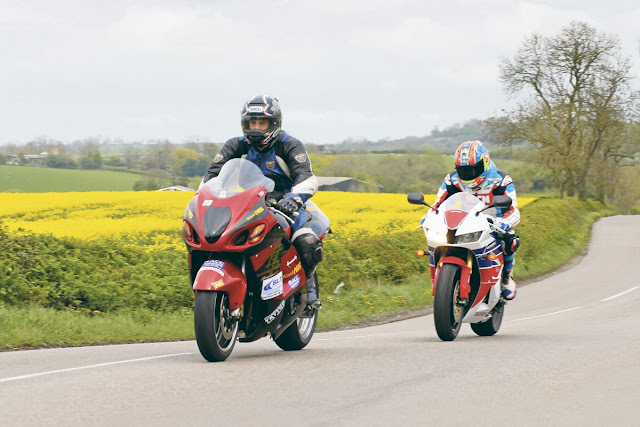Suzuki Hayabusa
The Hayabusa was far from the world’s most attractive superbike, but it was almost certainly the most aerodynamically efficient. Suzuki’s engineers spent hours in the wind tunnel fine-tuning not only its fairing, but also the mirrors, front mudguard and seat hump. The GSX’s slippery shape made a vital contribution to its amazing straight-line speed.
With its drooping fairing nose, large front mudguard and bulbous tail section, Suzuki’s Hayabusa was by common consent one of the least attractive superbikes ever launched by a major manufacturer. Yet the bike was a big success, and few riders who bought one had a bad word to say about its looks. There was a simple reason for that: the Hayabusa was designed this way to make it fast - and the result was a phenomenal top speed of 190mph (306km/h).
Suzuki’s objective had been to create the fastest bike in the world, which meant beating Honda’s Super Blackbird. That they succeeded was due in no small part to the ugly but aerodynamically efficient bodywork of the model known as the GSX1300R. To celebrate, Suzuki named the bike Hayabusa after an aggressive, fast-flying Japanese peregrine falcon whose prey just happened to include blackbirds.
Record-breaking horsepower
Beneath the bodywork the GSX was not especially hi-tech. Its 1298cc motor was essentially a larger, revamped version of the twin-cam, 16-valve unit from Suzuki’s GSX-R1100. The new unit had bigger valves and a reshaped combustion chamber. A gear-driven counterbalancer allowed it to be solidly mounted, increasing chassis rigidity. Fuel injection and a ram-air system - which forced cool air into the engine via the slots in the fairing nose - helped produce 173bhp at 9800rpm, a record for a production streetbike.
Chassis layout was conventional, with a twin- beam aluminium frame, upside-down front forks, and six-piston front brake calipers squeezing large 12.6in (320mm) discs. Other notable features were the vertically stacked twin headlights, which allowed the fairing nose to be narrow, and the ultra- thin, lightweight instrument panel.
The Hayabusa’s speed-influenced styling was much criticized, but to Suzuki’s credit there was much more to the bike than pure performance. For such a powerful machine it was versatile and easy to ride. At 4731b (215kg) the GSX was reasonably light, and its riding position was roomy and comfortable. Despite having a steering damper to aid stability, its steering was effortless and precise.
Even so, the main impression was one of outrageous power and speed. The big motor delivered instant, supremely strong acceleration throughout the rev range. Whether its tachometer needle was indicating 4000rpm or 9000rpm, the Hayabusa blasted forward like a guided missile. Provided its rider could keep the front wheel on the ground, it stormed through a standing quarter-mile in just ten seconds, reaching 60mph (97km/h) in under three. Even at 150mph (241 km/h) there was strong acceleration on tap. The bike was capable of showing more than 200mph (322km/h) on its slightly optimistic speedometer.
All that straight-line performance would have been a liability if the Hayabusa had not handled well, but Suzuki had put as much effort into the chassis as the engine. The frame was very rigid, and suspension at front and rear was excellent, giving a firm ride, yet soaking up most bumps. The brakes were very powerful, the specially developed Bridgestone tyres were grippy, and ground clearance was good. Some riders complained that the low, wind-cheating screen gave inadequate protection. But few had any serious complaints, especially in 2000 when the Hayabusa fought off Kawasaki’s ZX-12R to retain its unofficial 'world’s fastest bike’ title.
Some politicians and bureaucrats were less impressed, however. The following year, in response to a voluntary agreement between the major manufacturers (who were worried about future legal problems). Suzuki fitted the GSX with an electronic device that prevented it from reaching maximum revs in top gear, limiting top speed to 186mph (300km/h). The Hayabusa’s wings had been clipped - but its blend of speed and sophistication kept the unchanged Suzuki popular for several more years.
At high speed the Hayabusa’s ram-air system, fed via slots in the fairing nose, provided even mor
The view from the front was shaped almost entirely by scientific testing in the wind tunnel.
Specification Suzuki GSX1300R Hayabusa (1999)
- Engine Liquid-cooled dohc 16-valve four
- Capacity 1298cc (81 x 63mm)
- Maximum power 173bhp @ 9800rpm
- Transmission Six-speed, chain final drive
- Frame Aluminium twin spar
- Suspension Telescopic front; single shock rear
- Brakes Twin discs front; disc rear
- Weight 473lb (215kg)
- Top speed 190mph (306km/h)






















0 comments: